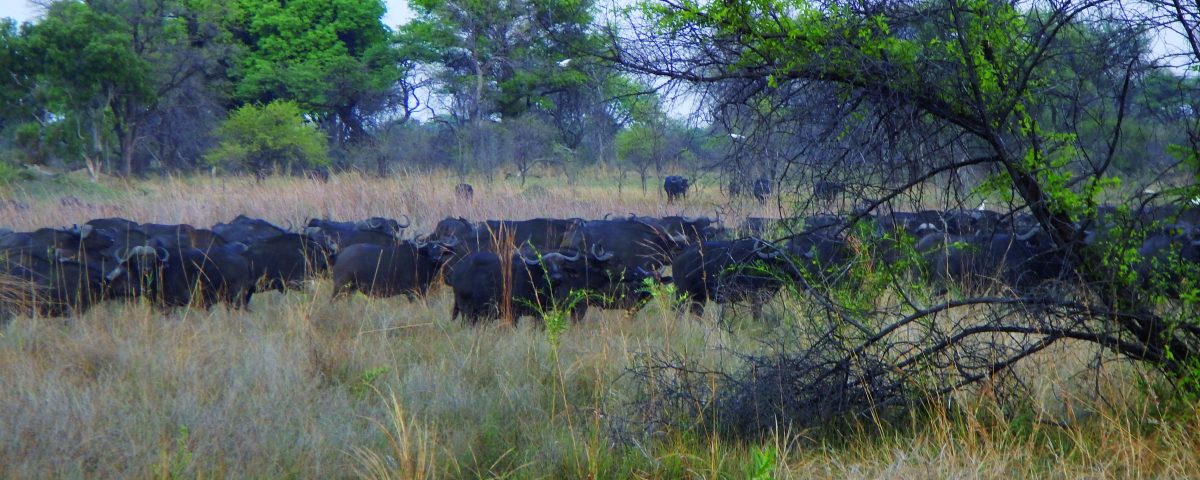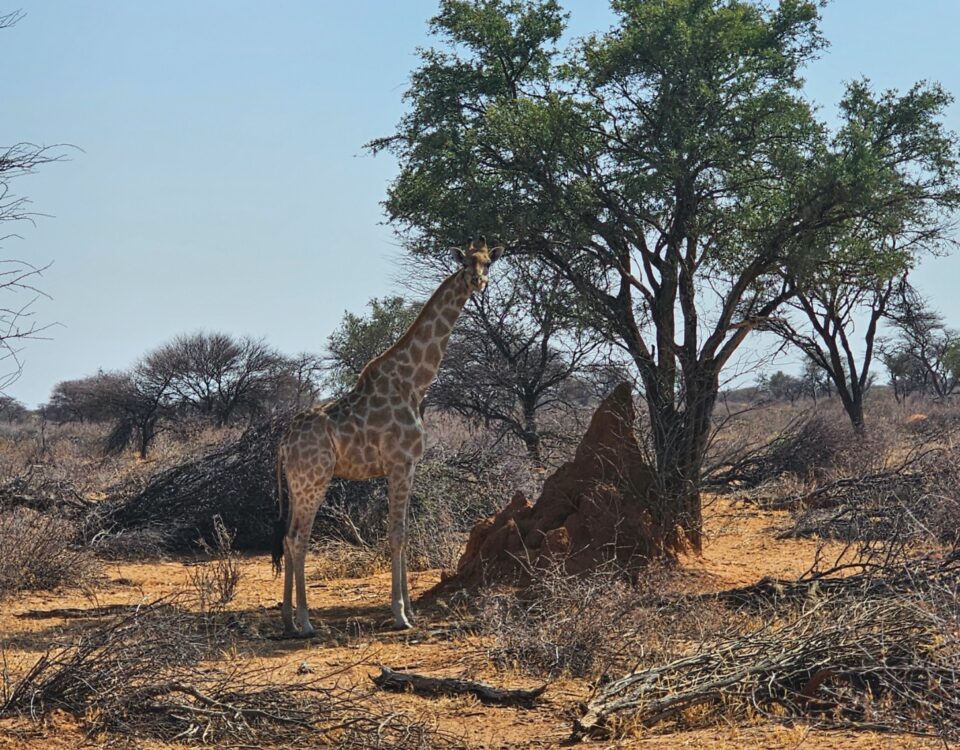
The Gentleman and the Kudu
January 9, 2019
On the spoor of Buffalo and Elephant in the Zambezi Region of Namibia
January 9, 2019This can be explained by the fact that the coarse, sweeping boss of the Cape buffalo harmoniously completes the picture of an almost indestructible animal which is well equipped to defend itself. Whereas other subspecies have smaller, less sturdy horns because they mostly or even exclusively prefer dense vegetation where they find shelter if need be, the Cape buffalo has conquered open grasslands as well, even though he also enjoys dense vegetation. Out on the savannah he relies on his physical strength, complemented by the enormous horns, as well as the protection provided by the herd, his courage and grim determination.
The dangerous nature of this usually placid bovine should not be dramatised, but there can be no doubt at all about this fact. If you have ever approached a large herd of buffalo in open savannah on foot, you will have experienced that the bovines repeatedly face you as a compact phalanx of muscular bodies. Some bulls usually take a few steps towards you, the troublemaker, and shake their massive heads in a threatening pose.
There is also no doubt about the sense of community among Cape buffalo. In times of danger, they help each other. The grim determination of a provoked buffalo is often discarded as a hunter’s cock-and-bull story. But it really exists – as the following experience, carefully authenticated and told by Mervin Cowie, illustrates.
In 1960 a group of Tsavo rangers had pitched their camp on the floodplains of the Galana River, in an area where four buffalo bulls were seen daily. One night a pride of nine lions appeared and killed one of the bulls in a noisy battle. The following morning the rangers watched the lions at their kill and they also noticed that one of the remaining three bulls left the area a few hours later. The other two, however, a younger bull and an old behemoth, remained in their home territory. A week later the rangers observed a single male lion attacking the young buffalo bull and toppling him over by leaping at him unexpectedly. When the bull on the ground started to bellow in desperation, the old one lunged at the lion and tossed him in the air with his head. The lion sustained a deep wound on his side and fled with a limp. In the meantime, the younger bull got back onto his feet and together with the old one began a relentless pursuit. Still, on the open grassland, they briefly managed to corner the glowering big cat crouching there, but then the lion was able to escape and hide in a small clump of shrubs. The two buffaloes then attacked the hiding place with their hooves and thrusts of their horns and demolished the shrubs to such an extent that the lion had to leave and fled into the open again. With terrific tenacity, the buffaloes resumed their pursuit of the lion and in the same manner, again attacked the small clumps of shrubs where the cat sought refuge. Fleeing from cover to cover, the desperate lion headed for the tree from where the rangers were watching, but noticed them and swerved towards the river. Briefly diverted by the presence of the rangers, the buffaloes lost sight of the lion but then continued the chase. The lion had fled into the water and walked a short distance downstream before getting out on the same side of the river. This tactic proved successful: the buffaloes lost his spoor for good. Confused as they were they doggedly searched for it nevertheless and thereby found the rest of the pride. They attacked them with incredible fury and the big cats scattered in all directions. At that point, the rangers felt so uneasy in the tree that they retreated. Even though they abandoned their amazing observation it still showed the tenacious determination with which buffaloes turn onto adversaries once they feel provoked beyond measure.
Buffaloes usually live in mixed herds of up to several hundred animals, sometimes even as many as two thousand. Older bulls are often solitary or form small groups. Bulls fight serious battles among each other during the rut.
Buffaloes have to drink every day and often frequent a body of water twice a day for extensive wallowing. Usually, they are accompanied by oxpeckers and Cattle Egrets. In dense bush and reeds, these birds are a tell-tale sign of the presence of buffalo.
While the lumbering bovines’ stoic behaviour towards human beings seems a little pointless in open grassland, this view changes immediately and drastically as soon as the buffalo hunt relocates to thick bush or even clumps of tall reeds or thickets of papyrus. In my opinion, the latter biotope, found in large parts of Mozambique, Botswana and Tanzania, is by far the most disagreeable place for hunting buffalo. A classical buffalo hunt consists of finding the spoor of an old bull or a group of dugga boys and follow it, often on the water, to the places where they rest.
Under normal circumstances, an encounter with buffaloes will hardly result in a dangerous situation. But just one characteristic form of buffalo behaviour is enough to make your adrenaline level shoot up: when a buffalo smells trouble he raises his head and with his nose stretched forward takes a few steps towards the disruption, all the while grimly looking at you from beneath his horns, now pointing backwards – it is the sort of look that Robert Ruark once described as: “He looks at you as if you owe him money”.
But then, since the buffalo is not injured and not provoked, he will without fail turn around and flee.
Careful shot placement is possibly the most important part of a buffalo hunt. Placement should be chosen in such a way that the projectile can penetrate the heart & lung complex. One should resist the temptation to take neck shots at too much of an angle, otherwise one might end up like Tony Challis – or worse.

Views differ on this question as well and somewhere else in this magazine you may find a different opinion. Personally, if circumstances allow, I prefer a position at a slight angle to shoot diagonally through the heart & lung complex and also hit the deep-lying spine or at least the nerve centres on it. When hit like that, a buffalo will collapse immediately and the diagonal shot through the heart & lung complex will cause a quick death. The shot must be placed where the neck meets the shoulder. In case of deviations, it ultimately doesn’t matter whether the buffalo standing broadside was hit in the paunch or the quartering buffalo was hit too far in the back and penetrated diagonally.
A projectile with deep penetration power is always a must, however. To the well-known quote ‘in every man, there is a child’ I would like to add ‘…but in every man, there is also a man’.
And that man’s ‘dearest child’ – even though in the age of emancipation and political correctness the man in the man is no longer in demand – is buffalo hunting.

CAPE BUFFALO
Sincerus caffer caffer
Shoulder height: 150 to 165 cm
Weight: 700 to 820 kg
Life expectancy: 18 to 20 years
Diet: Grass
Mating period: From September to December.
Gestation period: Due to the very long gestation period, mating as well as calving coincides with the rainy season. 11 months, 1 calf
Distribution: Southern and eastern Africa
Identification: Bull is larger, bulkier, distinct ram nose, clearly visible penis sheath, more or less marked boss. Females have thinner horns without boss.
This article was first published in HuntiNamibia 2018.


